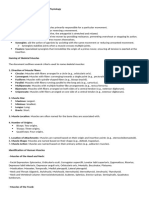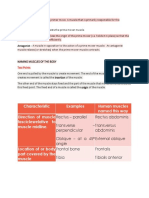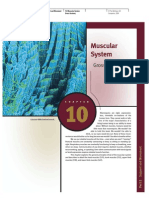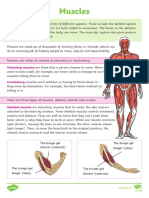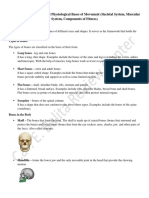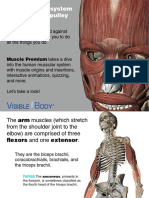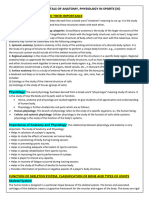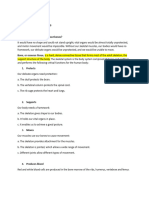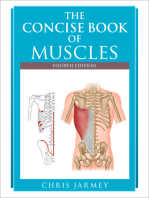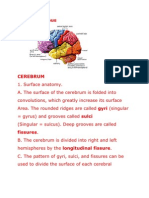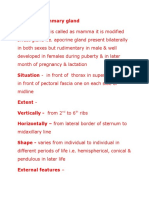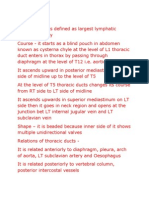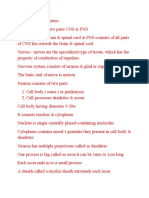0 ratings0% found this document useful (0 votes)
173 viewsMuscles
Muscles
Uploaded by
Dr santoshMuscles are defined as specialized tissue that has the property of contractibility. Muscles contain an origin and insertion point that are mostly attached to bones, and when the muscle contracts it moves the bone or joint. There are three main types of muscles in the body: voluntary/striated/skeletal muscles, involuntary/non-striated muscles like those in the gastrointestinal tract, and cardiac muscles which are striated but involuntary. The basic unit of muscle is the sarcomere, which contains the contractile proteins actin and myosin. Muscles are named based on factors like the number of heads, the region of the body, size, shape, action, and length. The main parts of a muscle are the belly
Copyright:
Attribution Non-Commercial (BY-NC)
Available Formats
Download as DOCX, PDF, TXT or read online from Scribd
Muscles
Muscles
Uploaded by
Dr santosh0 ratings0% found this document useful (0 votes)
173 views3 pagesMuscles are defined as specialized tissue that has the property of contractibility. Muscles contain an origin and insertion point that are mostly attached to bones, and when the muscle contracts it moves the bone or joint. There are three main types of muscles in the body: voluntary/striated/skeletal muscles, involuntary/non-striated muscles like those in the gastrointestinal tract, and cardiac muscles which are striated but involuntary. The basic unit of muscle is the sarcomere, which contains the contractile proteins actin and myosin. Muscles are named based on factors like the number of heads, the region of the body, size, shape, action, and length. The main parts of a muscle are the belly
Copyright
© Attribution Non-Commercial (BY-NC)
Available Formats
DOCX, PDF, TXT or read online from Scribd
Share this document
Did you find this document useful?
Is this content inappropriate?
Muscles are defined as specialized tissue that has the property of contractibility. Muscles contain an origin and insertion point that are mostly attached to bones, and when the muscle contracts it moves the bone or joint. There are three main types of muscles in the body: voluntary/striated/skeletal muscles, involuntary/non-striated muscles like those in the gastrointestinal tract, and cardiac muscles which are striated but involuntary. The basic unit of muscle is the sarcomere, which contains the contractile proteins actin and myosin. Muscles are named based on factors like the number of heads, the region of the body, size, shape, action, and length. The main parts of a muscle are the belly
Copyright:
Attribution Non-Commercial (BY-NC)
Available Formats
Download as DOCX, PDF, TXT or read online from Scribd
Download as docx, pdf, or txt
0 ratings0% found this document useful (0 votes)
173 views3 pagesMuscles
Muscles
Uploaded by
Dr santoshMuscles are defined as specialized tissue that has the property of contractibility. Muscles contain an origin and insertion point that are mostly attached to bones, and when the muscle contracts it moves the bone or joint. There are three main types of muscles in the body: voluntary/striated/skeletal muscles, involuntary/non-striated muscles like those in the gastrointestinal tract, and cardiac muscles which are striated but involuntary. The basic unit of muscle is the sarcomere, which contains the contractile proteins actin and myosin. Muscles are named based on factors like the number of heads, the region of the body, size, shape, action, and length. The main parts of a muscle are the belly
Copyright:
Attribution Non-Commercial (BY-NC)
Available Formats
Download as DOCX, PDF, TXT or read online from Scribd
Download as docx, pdf, or txt
You are on page 1of 3
Muscles
Are defined as specilised type of tissue which has
got property of contractibility
The word comes from the word mouse because
muscle shows two parts origin & insertion & a
fleshy belly
The origin & insertion are mostely attached to
bones & hence the muscle contracts the bone or
joint moves
The origin & insertion is called as attachment of
muscle
In our body there are three types of muscles
1. Voluntary /striated /skeletal
2. Involuntary / non striated – muscles which
are involuntary in action e.g. muscles of RS
GIT
3. Cardiac - striated but involuntary in action
The basic unit of muscle is sacromere
Sacromere has contractile protein are known as
actin & myocin
In striated muscles arrangement of actin & myocin
is regular there fore under microscope looks like
striation
In involuntary the arrangement of actin & myocin
is irregular hence looks like non striated
Nomenclature of muscle
1. The muscle are named on the basis of no. of
heads
a) Two heads or belly – biceps
b) Three heads - triceps
c) Four heads - quadriceps
2. Region it belongs
a) The side of face - temporalis
b) Arm – brachium - brachialis
c) Gluteal region - gleuteus maximus
3. Size of muscles
a) Big muscle - maximus
b) Small - minimus ,medius
4. According to shape
a) Muscles having quandrangular in shape –
quadratus
b) Like delta - deltoid
c) Like diamond - trapezius
5. According to action
a) Flexion of wrist – flexor carpi ulnaris
,radialis
b) Supination - supinator
c) Pronation - pronatar teres
d) Flexion of thumb - flexor pollicis longus
e) Extension
6. Length
a) Long - longus
b) Small – brevis
Parts of muscle - belly & tendon
Aponeurosis - flat tendon
You might also like
- JSS2 Basic Science Lesson Note PDFDocument40 pagesJSS2 Basic Science Lesson Note PDFJuddy ScienceNo ratings yet
- Shoulder Muscles ChartDocument2 pagesShoulder Muscles Chartapi-237415960No ratings yet
- Muscular SystemDocument30 pagesMuscular Systemzs2997020No ratings yet
- Myology: P By: M .HDocument60 pagesMyology: P By: M .HAklilu AbrhaNo ratings yet
- Muscles and MovementDocument4 pagesMuscles and MovementmcgarrigleNo ratings yet
- Muscles AnatomyDocument22 pagesMuscles AnatomyTalha GhauriNo ratings yet
- 5 - Muscular SystemDocument9 pages5 - Muscular Systemlnnlann2No ratings yet
- GROUP 8 - Chapter 10 - Muscular System Gross AnatomyDocument145 pagesGROUP 8 - Chapter 10 - Muscular System Gross Anatomygooglegirl18No ratings yet
- THE System FinalDocument20 pagesTHE System Finaltruc73185No ratings yet
- Lectr 6 Chap4, MusclesDocument54 pagesLectr 6 Chap4, MusclesKaleem MohammadNo ratings yet
- GA&E 6 - Intro To MyologyDocument47 pagesGA&E 6 - Intro To MyologySu ZikaiNo ratings yet
- Anatomy and Physiology of Muscular SystemDocument73 pagesAnatomy and Physiology of Muscular SystemRamanidhi SNo ratings yet
- WEEK 7 LAB EXERCISE - Muscular SystemDocument11 pagesWEEK 7 LAB EXERCISE - Muscular SystemMARY KATE L. CEBALLOSNo ratings yet
- Grade 6 - Body Movements - NotesDocument4 pagesGrade 6 - Body Movements - Notesanshth3heroNo ratings yet
- Anatomi Fisiologii - Id.enDocument24 pagesAnatomi Fisiologii - Id.enbaiq itaNo ratings yet
- The Muscular SystemDocument2 pagesThe Muscular SystemTay LenaNo ratings yet
- A. Quiz Reviewer Anatomy 10-15-2021Document19 pagesA. Quiz Reviewer Anatomy 10-15-2021Christian Cortez CabreraNo ratings yet
- 10 Muscular System Gross AnatomyDocument50 pages10 Muscular System Gross Anatomyvladu2004100% (1)
- The Muscular SystemDocument14 pagesThe Muscular SystemOana Maria FrancNo ratings yet
- Muscular System AnatomyDocument12 pagesMuscular System AnatomyTishonna DouglasNo ratings yet
- 16 MusclesDocument9 pages16 MusclesJoanna AaronNo ratings yet
- Naming MusclesDocument5 pagesNaming Musclesamannah2023No ratings yet
- 4 MyologyDocument57 pages4 MyologyAbhijith S. PNo ratings yet
- The Muscular System Powerpoint 1227697713114530 8Document44 pagesThe Muscular System Powerpoint 1227697713114530 8ninya puella100% (1)
- Anatomy_and_physiologyDocument22 pagesAnatomy_and_physiologyAnsh TomarNo ratings yet
- Anatomi - Olah Raga 1st MeetingDocument79 pagesAnatomi - Olah Raga 1st MeetingR DarmawanNo ratings yet
- Group 3 PathfitDocument21 pagesGroup 3 Pathfitangeloumali42No ratings yet
- MusclesDocument2 pagesMusclesTasnim MbarkiNo ratings yet
- PE20#1 The Muscular SystemDocument146 pagesPE20#1 The Muscular SystemJasmine GañganNo ratings yet
- VB Muscle Premium Preview 010714Document15 pagesVB Muscle Premium Preview 010714Draghici ValentinNo ratings yet
- The Term Muscle TissueDocument3 pagesThe Term Muscle Tissueximipa5.almadisyafarelinNo ratings yet
- Anatomical, Mechanical and Physiological Bases of Movement (Skeletal System, Muscular System, Components of Fitness) Lecture 2Document9 pagesAnatomical, Mechanical and Physiological Bases of Movement (Skeletal System, Muscular System, Components of Fitness) Lecture 2gierica sisonNo ratings yet
- HUBS191 Muscles ReferenceDocument25 pagesHUBS191 Muscles ReferenceEthan LimNo ratings yet
- Muscular SystemDocument1 pageMuscular SystemKareen ArnaizNo ratings yet
- Muscle Produce MovementDocument10 pagesMuscle Produce Movementtine84394No ratings yet
- Prof. Dr. Fouad Heikel.: Subject: Hip JointDocument6 pagesProf. Dr. Fouad Heikel.: Subject: Hip JointHashim OmarNo ratings yet
- Anatomy ASS Two FinishedDocument8 pagesAnatomy ASS Two Finishedhakimabrahim77No ratings yet
- Reviewer For Muscular SystemDocument8 pagesReviewer For Muscular SystemRegNo ratings yet
- Basic Anatomy PhysiologyDocument18 pagesBasic Anatomy PhysiologyJanina TorreNo ratings yet
- Musclar SystemDocument13 pagesMusclar Systemlangatcornel955No ratings yet
- VB Muscle Premium Preview 033015Document15 pagesVB Muscle Premium Preview 033015John DavidNo ratings yet
- Muscle Basics: - Over 600 Muscles in The Body - Each Is Attached To Bones or Other Structures by No Fewer Than 2 PointsDocument14 pagesMuscle Basics: - Over 600 Muscles in The Body - Each Is Attached To Bones or Other Structures by No Fewer Than 2 PointsOmar Duran CastroNo ratings yet
- Refined Muscular SystemDocument54 pagesRefined Muscular SystemogatojohnsonNo ratings yet
- Ch.7 NotesDocument8 pagesCh.7 NotesMohd ShaikhNo ratings yet
- MUSCULAR SYSTEM - ELOI BestDocument109 pagesMUSCULAR SYSTEM - ELOI BestEloisa Beltran AbquinaNo ratings yet
- Muscles Naming (Guided Learning)Document17 pagesMuscles Naming (Guided Learning)Amari WomackNo ratings yet
- Activity 3 & 4 (Module 3)Document4 pagesActivity 3 & 4 (Module 3)Marvin GasparNo ratings yet
- Human Body Major Muscle Regions-1Document4 pagesHuman Body Major Muscle Regions-1Chris Sevilla BurhamNo ratings yet
- Bones and Muscles of The Human BodyDocument20 pagesBones and Muscles of The Human BodyRoxana ValdezNo ratings yet
- Muscular Long ActivityDocument6 pagesMuscular Long Activity26jmuzychenkoNo ratings yet
- Theory and Palpation of Structures of The BodyDocument3 pagesTheory and Palpation of Structures of The BodyHammad -ullahNo ratings yet
- Reading 4 The Muscular SystemDocument16 pagesReading 4 The Muscular Systemlephuongvy1406No ratings yet
- POLINAR_CHAPTER 11Document20 pagesPOLINAR_CHAPTER 11Jayson PolinarNo ratings yet
- 7anatomy & Physiology (Xi) 240928 103328Document7 pages7anatomy & Physiology (Xi) 240928 103328NCNo ratings yet
- Exercise 6Document6 pagesExercise 6Gelo AlonzoNo ratings yet
- Pathfit ReviewerDocument7 pagesPathfit ReviewerbantayalagaNo ratings yet
- Introduction To AnatomyDocument57 pagesIntroduction To AnatomythrrishaNo ratings yet
- The Natural Rotator Cuff Healing Guide - Heal Your Cuff, Rid the Pain All On Your Own With Natural ExercisesFrom EverandThe Natural Rotator Cuff Healing Guide - Heal Your Cuff, Rid the Pain All On Your Own With Natural ExercisesRating: 5 out of 5 stars5/5 (1)
- CerebrumDocument12 pagesCerebrumDr santoshNo ratings yet
- HeartDocument12 pagesHeartDr santosh100% (1)
- BreastDocument6 pagesBreastDr santoshNo ratings yet
- Angle of Louis or Sterna AngleDocument1 pageAngle of Louis or Sterna AngleDr santoshNo ratings yet
- Thoracic DuctDocument2 pagesThoracic DuctDr santosh100% (1)
- CerebellumDocument5 pagesCerebellumDr santoshNo ratings yet
- Azygos VeinDocument2 pagesAzygos VeinDr santoshNo ratings yet
- Thalamus-: Disposition - It Lies Obliquely With Its Long AxisDocument8 pagesThalamus-: Disposition - It Lies Obliquely With Its Long AxisDr santoshNo ratings yet
- Lateral Ventricle: Number - Two in Number One On Each SideDocument4 pagesLateral Ventricle: Number - Two in Number One On Each SideDr santoshNo ratings yet
- Muscles of MasticationDocument2 pagesMuscles of MasticationDr santoshNo ratings yet
- CardioDocument29 pagesCardioDr santoshNo ratings yet
- BoneDocument4 pagesBoneDr santoshNo ratings yet
- Central Nervous SystemDocument2 pagesCentral Nervous SystemDr santoshNo ratings yet
- PONSDocument1 pagePONSDr santoshNo ratings yet
- Obturator NerveDocument3 pagesObturator NerveDr santoshNo ratings yet
- PancreasDocument8 pagesPancreasDr santosh100% (1)
- Paper Pattern of 1st Year BHMSDocument3 pagesPaper Pattern of 1st Year BHMSDr santosh100% (2)















